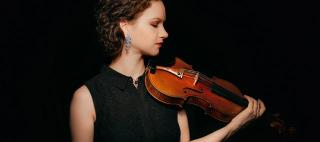|
Back
Delights from the Spanish Diaspora New York
David Geffen Hall, Lincoln Center
04/25/2024 - & April 26*, 27, 2024
Maurice Ravel: Rapsodie espagnole – Boléro
Alberto Ginastera: Concerto for Violin and Orchestra, Opus 30
Pablo de Sarasate: Concert Fantasy on ‘Carmen’, Opus 25
Hilary Hahn (Violin)
New York Philharmonic Orchestra, Gustavo Dudamel (Conductor)

H. Hahn (© Michael Patrick O’Leary)
“The excellence of natural Andalusian melody is revealed by the fact that it is the only music used continuously and abundantly by foreign composers.”
Manuel de Falla
Promoted as “Sounds of Spain”, this week’s New York Philharmonic programs would more appropriately be named “Sounds of the Spanish Diaspora”. Venezuelan-born Gustavo Dudamel (replacing the ailing Basque conductor Juanjo Mena), Argentinian Alberto Ginastera, and partly Basque Maurice Ravel. As for the Spanish-born Pablo de Sarasate, his Carmen concert piece was an extravaganza on a French composer’s Gallic impression of a Spanish opera.
The result of this Iberian-émigré mixture? Excitement, passion, extraordinary solo violin playing and, if not totally Spanish, the Andalusian equivalent of Spain’s la gloria itself.
Three of the pieces were old warhorses. One work, Alberto Ginastera’s Concerto for Violin and Orchestra was Ms. Hahn’s miracle.
Admittedly, I had been ignorant of the work before last night, as have most music-lovers. It had been commissioned by the New York Phil, premiered by Ruggiero Ricci and Leonard Bernstein in 1963 and has never been repeated in New York.
The reason is obvious: I imagine few fiddlers fiddler outside of Ricci–and this week’s Hilary Hahn– could start with a six‑minute cadenza of alarming difficulty–and continue with 11 minutes of even more terrifying challenges.
And that was only the first movement.
As forchallenges, Ms. Hahn’s work encompassed every Herculean (or more appropriately, Dionysiac) challenge. With the greatest velocity, triple stringing, quarter tones, dissonant harmonies, four‑part chords, wild arpeggios. And in that original cadenzas, these were not climaxes: they were all part of a gnarly tone row! After this, the seven percussionists and the NY Phil played short intervals–leaving room for Ms. Hahn to tear the Carnegie Hall apart.
One of Ginastera’s “last period” works (he had started with nationalistic music), he experimented in the second movement with Ms. Hahn playing against 22 solo instruments. In pairs, trios and rambunctious fiddling by the soloist herself against a solo string quartet, solo flutes, trumpets etc and a pair of boisterous drummers!
More experimenting in the last movement, given the tangled title Scherzo pianissimo and Perpetuum mobile. Plus (said the composer) “to be played at a flying pace, in a mysterious, barely audible whisper.”
That described not only Ms. Hahn, but Mr. Dudamel. Coming in the last minute, never having conducted this, he led the complex orchestral writing with both skill and spirit.
Did Ms. Hahn triumph? Well, for pure skill, for non‑stop brilliance, this was great stuff. Did she make the Concerto warm? Memorable? Affectionate? Nah. No more than a quark algorithm could be warm and affection. As for virtuosity, they and I were overwhelmed at the fierceness and deft handling of...,well, of everything.
So they rightly raved at Ms. Hahn’s skill. But for warmth, affection and equal skill, Sarasate’s Carmen Concert Fantasy was the ideal. No matter how many times, the soloist has played this, it is always blazing, both utterly familiar (Sarasate took nearly all the arias) and utterly original (with Ms. Hahn taking the virtuoso-composer’s most difficult and lyrical passages with both insouciance and aplomb).
Which left the bookends, two works by Maurice Ravel. Mr. Dudamel offered an impressionistic first movement to the Rapsodie espagnole, whispering, trembling perhaps with a plethora of unneeded retards. The last three movements filled with terpsichorean energy.
As for Boléro, Ravel may have begrudged its popularity, but listening to the Phil play it, every shadow, nuance, shade showed his genius. When it came to that last‑minute modulation and 15‑minute crescendo, this was more than Dudamel’s forte. It was his pianissimo leading to his forte and forte fortissimo, an ever‑shifting musical rainbow, played with pinpoint accuracy.
Harry Rolnick
|